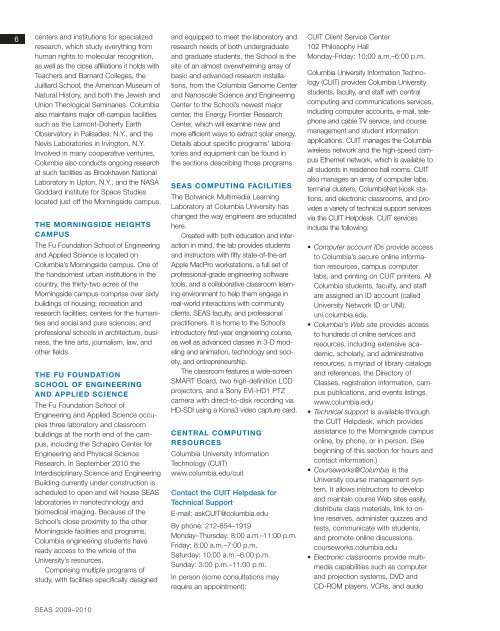2009-2010 Bulletin â PDF - SEAS Bulletin - Columbia University
2009-2010 Bulletin â PDF - SEAS Bulletin - Columbia University
2009-2010 Bulletin â PDF - SEAS Bulletin - Columbia University
Create successful ePaper yourself
Turn your PDF publications into a flip-book with our unique Google optimized e-Paper software.
6<br />
centers and institutions for specialized<br />
research, which study everything from<br />
human rights to molecular recognition,<br />
as well as the close affiliations it holds with<br />
Teachers and Barnard Colleges, the<br />
Juilliard School, the American Museum of<br />
Natural History, and both the Jewish and<br />
Union Theological Seminaries. <strong>Columbia</strong><br />
also maintains major off-campus facilities<br />
such as the Lamont-Doherty Earth<br />
Observatory in Palisades, N.Y., and the<br />
Nevis Laboratories in Irvington, N.Y.<br />
Involved in many cooperative ventures,<br />
<strong>Columbia</strong> also conducts ongoing research<br />
at such facilities as Brookhaven National<br />
Laboratory in Upton, N.Y., and the NASA<br />
Goddard Institute for Space Studies<br />
located just off the Morningside campus.<br />
THE MORNINGSIDE HEIGHTS<br />
CAMPUS<br />
The Fu Foundation School of Engineering<br />
and Applied Science is located on<br />
<strong>Columbia</strong>’s Morningside campus. One of<br />
the handsomest urban institutions in the<br />
country, the thirty-two acres of the<br />
Morningside campus comprise over sixty<br />
buildings of housing; recreation and<br />
research facilities; centers for the humanities<br />
and social and pure sciences; and<br />
professional schools in architecture, business,<br />
the fine arts, journalism, law, and<br />
other fields.<br />
THE FU FOUNDATION<br />
SCHOOL OF ENGINEERING<br />
AND APPLIED SCIENCE<br />
The Fu Foundation School of<br />
Engineering and Applied Science occupies<br />
three laboratory and classroom<br />
buildings at the north end of the campus,<br />
including the Schapiro Center for<br />
Engineering and Physical Science<br />
Research. In September <strong>2010</strong> the<br />
Interdisciplinary Science and Engineering<br />
Building currently under construction is<br />
scheduled to open and will house <strong>SEAS</strong><br />
laboratories in nanotechnology and<br />
biomedical imaging. Because of the<br />
School’s close proximity to the other<br />
Morningside facilities and programs,<br />
<strong>Columbia</strong> engineering students have<br />
ready access to the whole of the<br />
<strong>University</strong>’s resources.<br />
Comprising multiple programs of<br />
study, with facilities specifically designed<br />
and equipped to meet the laboratory and<br />
research needs of both undergraduate<br />
and graduate students, the School is the<br />
site of an almost overwhelming array of<br />
basic and advanced research installations,<br />
from the <strong>Columbia</strong> Genome Center<br />
and Nanoscale Science and Engineering<br />
Center to the School’s newest major<br />
center, the Energy Frontier Research<br />
Center, which will examine new and<br />
more efficient ways to extract solar energy.<br />
Details about specific programs’ laboratories<br />
and equipment can be found in<br />
the sections describing those programs.<br />
<strong>SEAS</strong> COMPUTING FACILITIES<br />
The Botwinick Multimedia Learning<br />
Laboratory at <strong>Columbia</strong> <strong>University</strong> has<br />
changed the way engineers are educated<br />
here.<br />
Created with both education and interaction<br />
in mind, the lab provides students<br />
and instructors with fifty state-of-the-art<br />
Apple MacPro workstations, a full set of<br />
professional-grade engineering software<br />
tools, and a collaborative classroom learning<br />
environment to help them engage in<br />
real-world interactions with community<br />
clients, <strong>SEAS</strong> faculty, and professional<br />
practitioners. It is home to the School’s<br />
introductory first-year engineering course,<br />
as well as advanced classes in 3-D modeling<br />
and animation, technology and society,<br />
and entrepreneurship.<br />
The classroom features a wide-screen<br />
SMART Board, two high-definition LCD<br />
projectors, and a Sony EVI-HD1 PTZ<br />
camera with direct-to-disk recording via<br />
HD-SDI using a Kona3 video capture card.<br />
CENTRAL COMPUTING<br />
RESOURCES<br />
<strong>Columbia</strong> <strong>University</strong> Information<br />
Technology (CUIT)<br />
www.columbia.edu/cuit<br />
Contact the CUIT Helpdesk for<br />
Technical Support<br />
E-mail: askCUIT@columbia.edu<br />
By phone: 212-854–1919<br />
Monday–Thursday: 8:00 a.m.–11:00 p.m.<br />
Friday: 8:00 a.m.–7:00 p.m.<br />
Saturday: 10:00 a.m.–6:00 p.m.<br />
Sunday: 3:00 p.m.–11:00 p.m.<br />
In person (some consultations may<br />
require an appointment):<br />
CUIT Client Service Center<br />
102 Philosophy Hall<br />
Monday-Friday: 10:00 a.m.–6:00 p.m.<br />
<strong>Columbia</strong> <strong>University</strong> Information Technology<br />
(CUIT) provides <strong>Columbia</strong> <strong>University</strong><br />
students, faculty, and staff with central<br />
computing and communications services,<br />
including computer accounts, e-mail, telephone<br />
and cable TV service, and course<br />
management and student information<br />
applications. CUIT manages the <strong>Columbia</strong><br />
wireless network and the high-speed campus<br />
Ethernet network, which is available to<br />
all students in residence hall rooms. CUIT<br />
also manages an array of computer labs,<br />
terminal clusters, <strong>Columbia</strong>Net kiosk stations,<br />
and electronic classrooms, and provides<br />
a variety of technical support services<br />
via the CUIT Helpdesk. CUIT services<br />
include the following:<br />
• Computer account IDs provide access<br />
to <strong>Columbia</strong>’s secure online information<br />
resources, campus computer<br />
labs, and printing on CUIT printers. All<br />
<strong>Columbia</strong> students, faculty, and staff<br />
are assigned an ID account (called<br />
<strong>University</strong> Network ID or UNI).<br />
uni.columbia.edu.<br />
• <strong>Columbia</strong>’s Web site provides access<br />
to hundreds of online services and<br />
resources, including extensive academic,<br />
scholarly, and administrative<br />
resources, a myriad of library catalogs<br />
and references, the Directory of<br />
Classes, registration information, campus<br />
publications, and events listings.<br />
www.columbia.edu<br />
• Technical support is available through<br />
the CUIT Helpdesk, which provides<br />
assistance to the Morningside campus<br />
online, by phone, or in person. (See<br />
beginning of this section for hours and<br />
contact information.)<br />
• Courseworks@<strong>Columbia</strong> is the<br />
<strong>University</strong> course management system.<br />
It allows instructors to develop<br />
and maintain course Web sites easily,<br />
distribute class materials, link to online<br />
reserves, administer quizzes and<br />
tests, communicate with students,<br />
and promote online discussions.<br />
courseworks.columbia.edu<br />
• Electronic classrooms provide multimedia<br />
capabilities such as computer<br />
and projection systems, DVD and<br />
CD-ROM players, VCRs, and audio<br />
<strong>SEAS</strong> <strong>2009</strong>–<strong>2010</strong>







